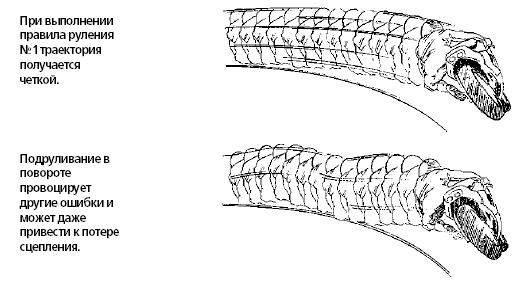  
 
 
 
 
 
 
 
 
 
 
 
 
  

|
The Chapter 14. Taxiing - rule
How much time you taxi in turn? And how much it is necessary to taxi time,
on yours,? A right answer - one taxiing on one turn. It - rule of taxiing
¹1.
" Taxiing in turn ", i.e. one or several padding taxiing, not that
diverse, as a Development of a self-preservative Instinct, working on the
causes, already familiar to us, - has come too fast, too widely, I am not
inscribed in turn etc. With the help of taxiing the racers attempt to
correct errors accomplished at a going into turn.
The taxiing in turn is SPI #3. Unfortunately, this SPI, as well as all
other, works against the racer, degrades a controllability and contradicts a
design of a motorcycle.

Unstable gas and angle of lean
Let's consider more detail, this how works SPI. So, the racer falls in a
situation, which one is not pleasant to him (for example, catches to turn
too widely), and decides to correct by its padding taxiing. However, as a
result of his operatings there is more abruptly angle of lean bike. Want
trust, want no, but this error is widespread also widely, as well as
attachment / sea disposal of gas in turn.
And, as a rule, attachment / sea disposal of gas goes an hand about an
hand with taxiing. It enhances undesirable changes weight, hinders the
suspension to work and degrades coupling with a road. Let's allow now, that
the racer correctly operates gas, but thus taxis up. Thereby he augments
angle of lean, that results in reduction coupling on road and degrades
stability bike. And at last, the taxiing changes landing the racer in the
middle of turn. In general, circle of one error. Therefore, one taxiing on
one turn ideal version.
Slips on low speed.
To each year and I, and my instructors, we auscultator from our students
of a history about the drifts which have happened in this or that turn. We
looked their outcomes (seconds on 15 worse, than a record of a route) and
nothing perceived.
The riddle was settled, when we have understood, that they taxi up in
turn and simultaneously add / throttle back, as results in small drifts. The
racers, feeling drift, also degrade a situation, committing at once some
errors: (1) rectify bike to stabilize it (2) see, that are not entered (3)
and more tilt bike, more strongly attempting to not depart (but all
the same sometimes take off).
The cause - in you
It is possible to find many explanations to errors. But main cause in you.
The evidences? Well for example, see rapid motions and consider, how much
time is changed angle of lean by the leading figures.
Each rule has exceptions, and for a rule of taxiing ¹1 - too. I do not
think, that someone always does all correctly. It is not necessary to be
ashamed of small taxiings in turn. Loss of coupling or knoll, having jumped
up on which one bike change route, cause to taxi up even the foremans.
However it is necessary legiblly to perceive, that these taxiings are
executed so precisely and continuously, that them it is even not visible
from the party.
And more - 90 % of these taxiings not that diverse as SPI, and from them
is quite possible to refuse. In any moment the racer perceives, that the
attachment / sea disposal of gas is an error and ceases it to do. As well
with taxiing. We have learned to demonstrate it to the students by ours
Superbike School. We simplly establish the chamber above a shoulder, and
then roll a film. In a record it is visible, that some do up to five
taxiings in one turn, and all his is in the final accounting waste! That is,
if them were not, the motorcycle would leave turn in the same point, where
would result his very first taxiing on a going into turn.
Aim and forget
The ground rule: execute taxiing by one realized operating and do not
think any more of a nem. There are things and is more relevant, that and is
necessary to give them attention in turn. Than the beam less taxiings - that
better. One taxiing on one turn - ideal
The cause of errors with gas and with taxiing contains that you do not
know, as far as is fast and as far as slowly you can turn. Try on training
to turn maximum fast and maximum slowly. So you will find range, in which
one can normally work. I precisely know, when I leave for the range. It when
to me should be retained bike from dip. DG
|